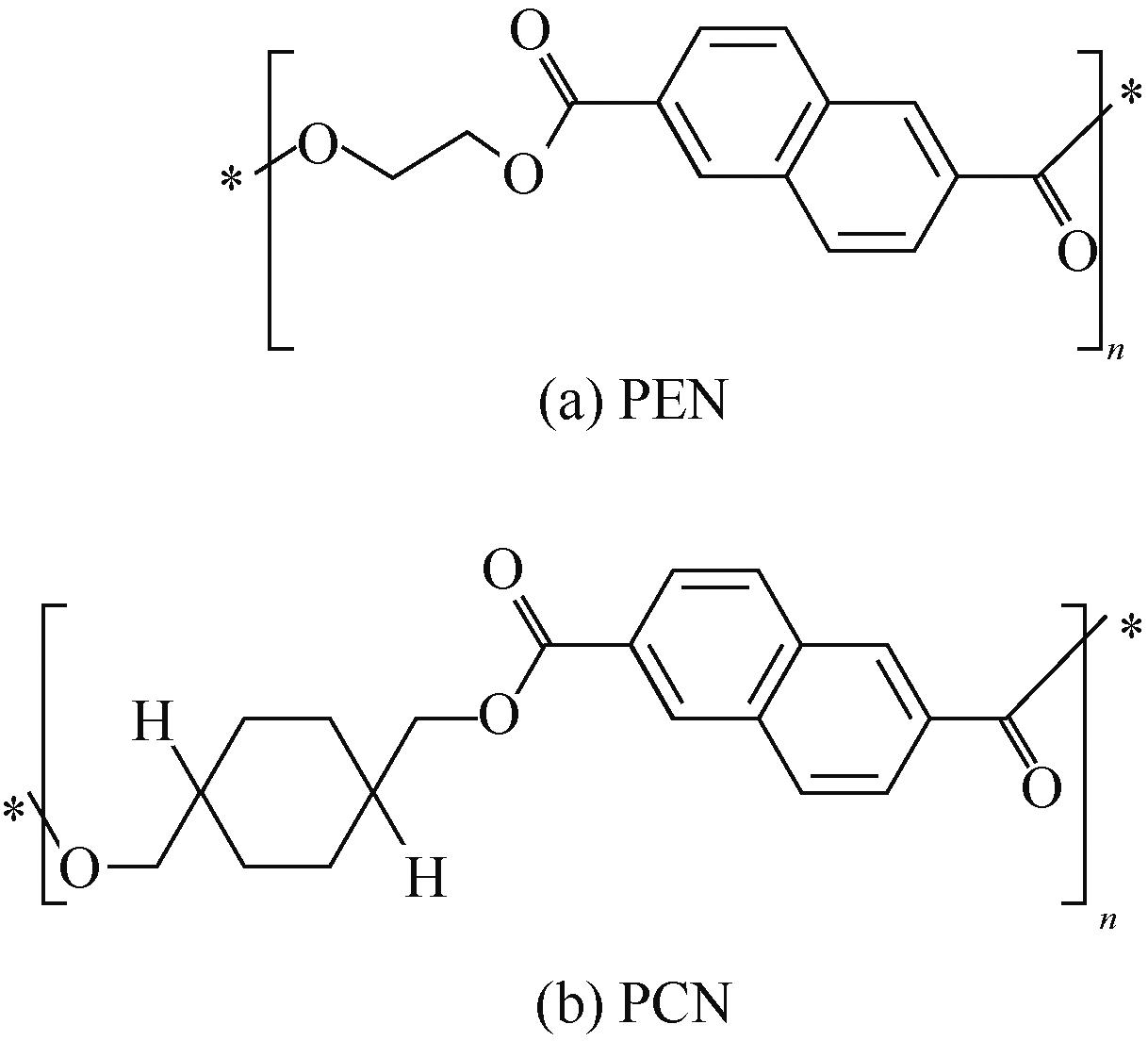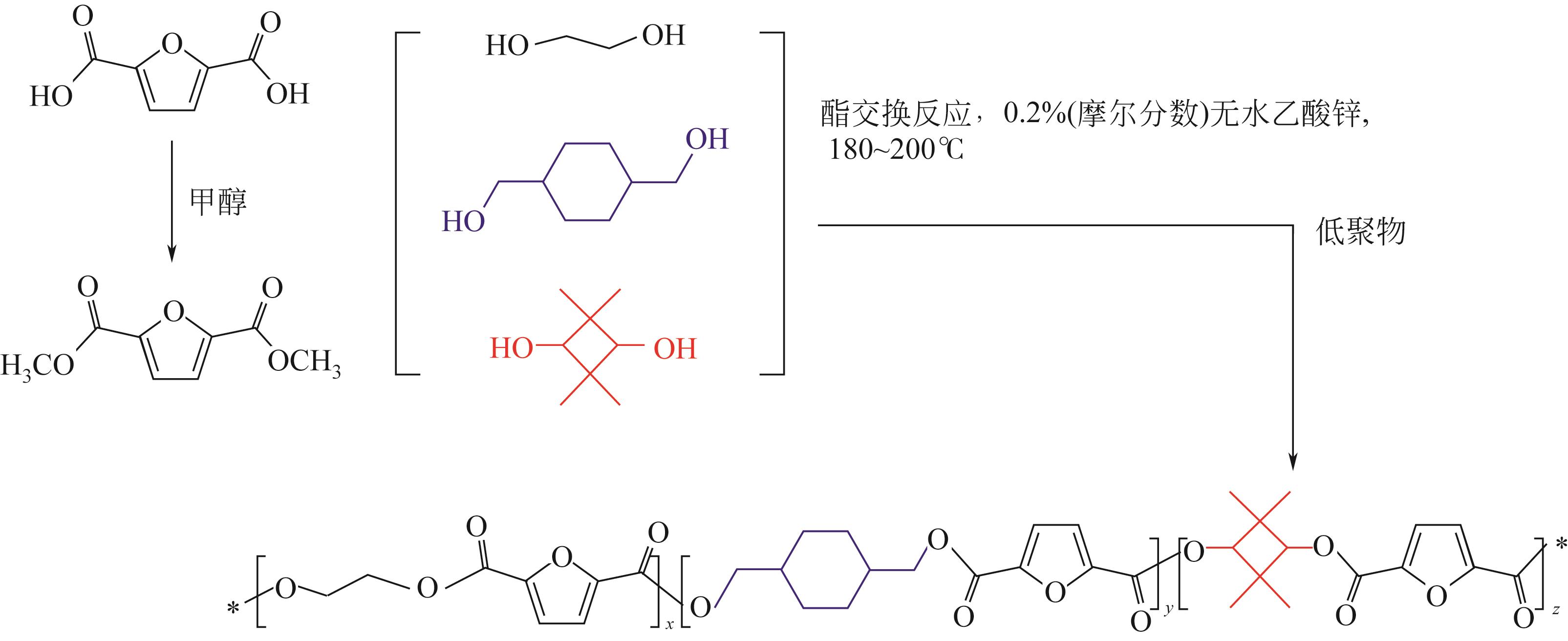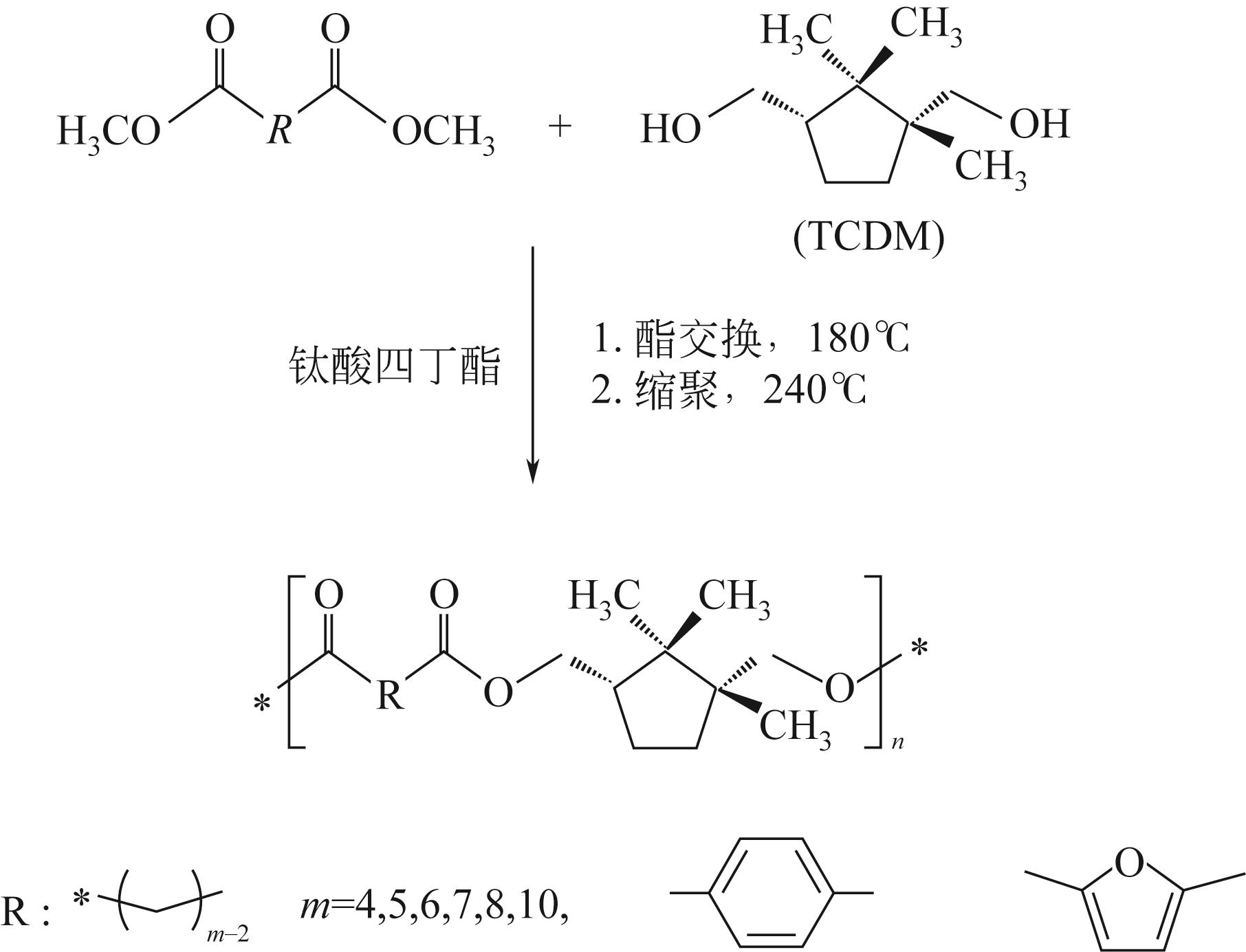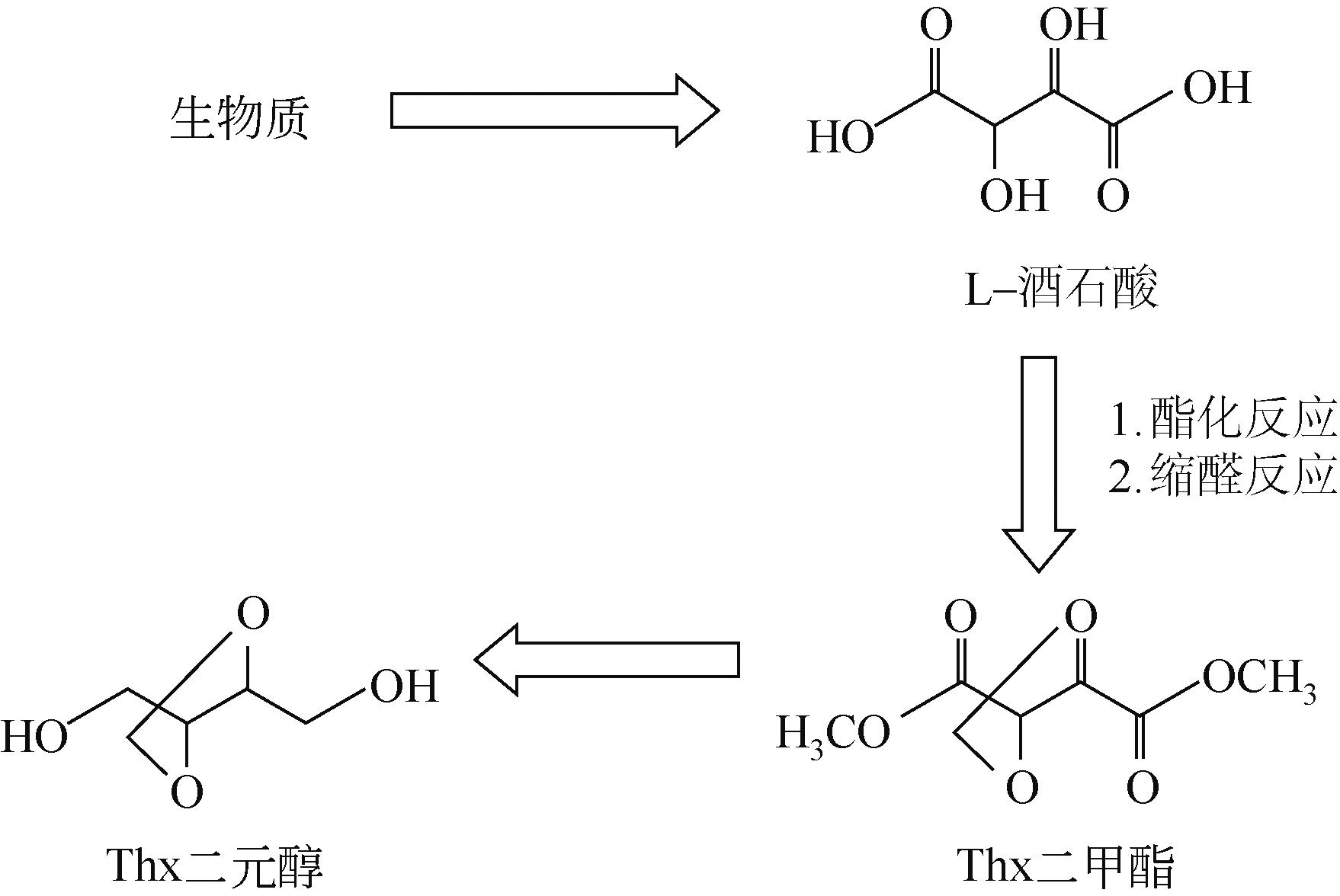化工进展 ›› 2023, Vol. 42 ›› Issue (5): 2555-2565.DOI: 10.16085/j.issn.1000-6613.2022-2069
高玻璃化转变温度抗冲击透明聚酯的研究进展
戴行1,2( ), 高瑞雪1,2, 李奕国1, 朱锦2, 王静刚2(
), 高瑞雪1,2, 李奕国1, 朱锦2, 王静刚2( )
)
- 1.宁波大学材料科学与化学工程学院,浙江 宁波 315211
2.中国科学院宁波材料技术与工程研究所高分子与 复合材料实验室,浙江 宁波 315201
-
收稿日期:2022-11-07修回日期:2023-01-01出版日期:2023-05-10发布日期:2023-06-02 -
通讯作者:王静刚 -
作者简介:戴行(1998—),男,硕士研究生,研究方向为生物基高耐热聚酯。E-mail:daihang@nimte.ac.cn。 -
基金资助:国家重点研发计划(2021YFB3700300)
Research progress on the synthesis of excellent impact and transparency polyesters with high glass transition temperature
DAI Hang1,2( ), GAO Ruixue1,2, LI Yiguo1, ZHU Jin2, WANG Jinggang2(
), GAO Ruixue1,2, LI Yiguo1, ZHU Jin2, WANG Jinggang2( )
)
- 1.School of Material Science and Chemical Engineering, Ningbo University, Ningbo 315211, Zhejiang, China
2.Laboratory of Polymers and Composites, Ningbo Institute of Materials Technology and Engineering, Chinese Academy of Sciences, Ningbo 315201, Zhejiang, China
-
Received:2022-11-07Revised:2023-01-01Online:2023-05-10Published:2023-06-02 -
Contact:WANG Jinggang
摘要:
高玻璃化转变温度(Tg)、抗冲击透明聚酯具有高耐热、高透明和优异的力学性能等优点,广泛应用于厨电产品、汽车制造等领域,但目前存在原料不可再生、耐热温度不够高和品种单一等问题。本文根据刚性二元酸或刚性二元醇单体来源的不同,介绍了石油基高耐热聚酯和生物基高耐热聚酯的研究进展,其中石油基高耐热聚酯包括基于2,6-萘二甲酸、4,4'-联苯二甲酸和2,2,4,4-四甲基-1,3-环丁二醇等刚性单体聚酯;生物基高耐热聚酯包括基于呋喃二甲酸、木质素衍生物二酸、天然樟脑及其衍生单体、酒石酸、樟脑醇、异己糖醇等刚性单体聚酯。指出生物基呋喃二甲酸和异山梨醇聚酯是未来高耐热聚酯商业化的重要选择,而原料来源可持续、更高的耐热温度、优异的韧性是未来高Tg、抗冲透明聚酯的主要发展方向。
中图分类号:
引用本文
戴行, 高瑞雪, 李奕国, 朱锦, 王静刚. 高玻璃化转变温度抗冲击透明聚酯的研究进展[J]. 化工进展, 2023, 42(5): 2555-2565.
DAI Hang, GAO Ruixue, LI Yiguo, ZHU Jin, WANG Jinggang. Research progress on the synthesis of excellent impact and transparency polyesters with high glass transition temperature[J]. Chemical Industry and Engineering Progress, 2023, 42(5): 2555-2565.
| 1 | CAKMAK M, WANG Y D, SIMHAMBHATLA M. Processing characteristics, structure development, and properties of uni and biaxially stretched poly(ethylene 2,6-naphthalate) (PEN) films[J]. Polymer Engineering & Science, 1990, 30(12): 721-733. |
| 2 | JEONG Young Gyu, Won Ho JO, LEE Sang Cheol. Synthesis and isodimorphic cocrystallization behavior of poly(1,4-cyclohexylenedimethylene terephthalate-co-1,4-cyclohexylenedimethylene 2,6-naphthalate) copolymers[J]. Journal of Polymer Science B: Polymer Physics, 2004, 42(1): 177-187. |
| 3 | KASMI N, TERZOPOULOU Z, PAPAGEORGIOU G Z, et al. Poly(1,4-cyclohexanedimethylene 2,6-naphthalate) polyester with high melting point: Effect of different synthesis methods on molecular weight and properties[J]. Express Polymer Letters, 2018, 12(3): 227-237. |
| 4 | WANG Guoqiang, YU Jiayi, JIANG Min, et al. Bio-based copolyesters poly(butylene 2,6-naphthalate-co-butylene furandicarboxylate) derived from 2,5-furandicarboxylic acid (FDCA): Synthesis, characterization, and properties[J]. Polymer Testing, 2020, 91: 106771. |
| 5 | WANG Guoqiang, YANG Guitang, JIANG Min, et al. Poly(propylene naphthalate-co-propylene 2,5-thiophenedicarboxylate)s derived from bio-based 2,5-thiophenedicarboxylic acid (TDCA): Synthesis and properties[J]. Polymer Testing, 2021, 93: 106955. |
| 6 | TOKITA Masatoshi, WATANABE Junji. Several interesting fields exploited through understanding of polymeric effects on liquid crystals of main-chain polyesters[J]. Polymer Journal, 2006, 38(7): 611-638. |
| 7 | MONDSCHEIN Ryan J, DENNIS Joseph M, LIU Haoyu, et al. Synthesis and characterization of amorphous bibenzoate (co)polyesters: Permeability and rheological performance[J]. Macromolecules, 2017, 50(19): 7603-7610. |
| 8 | MONDSCHEIN Ryan J, DENNIS Joseph M, LIU Haoyu, et al. Influence of bibenzoate regioisomers on cyclohexanedimethanol-based (co)polyester structure-property relationships[J]. Macromolecules, 2019, 52(3): 835-843. |
| 9 | Eliot EDLING H, LIU Haoyu, SUN Hua, et al. Copolyesters based on bibenzoic acids[J]. Polymer, 2018, 135: 120-130. |
| 10 | KELSEY Donald R, SCARDINO Betty M, GREBOWICZ Janusz S, et al. High impact, amorphous terephthalate copolyesters of rigid 2,2,4,4-tetramethyl-1,3-cyclobutanediol with flexible diols[J]. Macromolecules, 2000, 33(16): 5810-5818. |
| 11 | BEALL Gary W, POWELL Clois E, HANCOCK Jesse, et al. Physical properties of CBDO based co-polyterephthalate nanocomposites[J]. Applied Clay Science, 2007, 37(3/4): 295-306. |
| 12 | ZHANG Musan, MOORE Robert B, LONG Timothy E. Melt transesterification and characterization of segmented block copolyesters containing 2,2,4,4-tetramethyl-1,3-cyclobutanediol[J]. Journal of Polymer Science A: Polymer Chemistry, 2012, 50(18): 3710-3718. |
| 13 | BANERJEE Aanindeeta, DICK Graham R, YOSHINO Tatsuhiko, et al. Carbon dioxide utilization via carbonate-promoted C—H carboxylation[J]. Nature, 2016, 531(7593): 215-219. |
| 14 | FEI Xuan, WANG Jinggang, ZHANG Xiaoqin, et al. Recent progress on bio-based polyesters derived from 2,5-furandicarbonxylic acid (FDCA)[J]. Polymers, 2022, 14(3): 625. |
| 15 | WANG Jinggang, LIU Xiaoqing, ZHANG Yajie, et al. Modification of poly(ethylene 2,5-furandicarboxylate) with 1,4-cyclohexanedimethylene: Influence of composition on mechanical and barrier properties[J]. Polymer, 2016, 103: 1-8. |
| 16 | WANG Jinggang, LIU Xiaoqing, JIA Zhen, et al. Modification of poly(ethylene 2,5-furandicarboxylate) (PEF) with 1,4-cyclohexanedimethanol: Influence of stereochemistry of 1,4-cyclohexylene units[J]. Polymer, 2018, 137: 173-185. |
| 17 | WANG Jinggang, LIU Xiaoqing, JIA Zhen, et al. Synthesis of bio-based poly(ethylene 2,5‐furandicarboxylate) copolyesters: Higher glass transition temperature, better transparency, and good barrier properties[J]. Journal of Polymer Science A: Polymer Chemistry, 2017, 55(19): 3298-3307. |
| 18 | WANG Jinggang, LIU Xiaoqing, ZHU Jin, et al. Copolyesters based on 2,5-furandicarboxylic acid (FDCA): Effect of 2,2,4,4-tetramethyl-1,3-cyclobutanediol units on their properties[J]. Polymers, 2017, 9(9): 305. |
| 19 | WANG Jinggang, MAHMUD Sakil, ZHANG Xiaoqin, et al. Bio-based amorphous polyesters with high Tg: Trade-off between rigid and flexible cyclic diols[J]. ACS Sustainable Chemistry & Engineering, 2019, 7(6): 6401-6411. |
| 20 | KAINULAINEN Tuomo P, GOWDA Vasantha, HEISKANEN Juha P, et al. Weathering of furan and 2,2'-bifuran polyester and copolyester films[J]. Polymer Degradation and Stability, 2022, 200: 109960. |
| 21 | KAINULAINEN Tuomo P, SIRVIÖ Juho A, SETHI Jatin, et al. UV-blocking synthetic biopolymer from biomass-based bifuran diester and ethylene glycol[J]. Macromolecules, 2018, 51(5): 1822-1829. |
| 22 | KAINULAINEN Tuomo P, HUKKA Terttu I, ÖZEREN Hüsamettin D, et al. Utilizing furfural-based bifuran diester as monomer and comonomer for high-performance bioplastics: Properties of poly(butylene furanoate), poly(butylene bifuranoate), and their copolyesters[J]. Biomacromolecules, 2020, 21(2): 743-752. |
| 23 | ZHANG Yunfan, ENOMOTO Yukiko, IWATA Tadahisa. Synthesis and characterization of biphenyl polyesters derived from divanillic acid and cyclic diols[J]. Polymer, 2020, 203: 122751. |
| 24 | NGUYEN Ha Thi Hoang, REIS Marcus H, QI Pengxu, et al. Polyethylene ferulate (PEF) and congeners: Polystyrene mimics derived from biorenewable aromatics[J]. Green Chemistry, 2015, 17(9): 4512-4517. |
| 25 | DING Lei, LIU Li, CHEN Yifan, et al. Modification of poly(ethylene terephthalate) by copolymerization of plant-derived α-truxillic acid with excellent ultraviolet shielding and mechanical properties[J]. Chemical Engineering Journal, 2019, 374: 1317-1325. |
| 26 | SHAHNI Rahul K, MABIN Micah, WANG Zhihan, et al. Synthesis and characterization of BPA-free polyesters by incorporating a semi-rigid cyclobutanediol monomer[J]. Polymer Chemistry, 2020, 11(37): 6081-6090. |
| 27 | NSENGIYUMVA Olivier, MILLER Stephen A. Synthesis, characterization, and water-degradation of biorenewable polyesters derived from natural camphoric acid[J]. Green Chemistry, 2019, 21(5): 973-978. |
| 28 | GARLOTTA Donald. A literature review of poly(lactic acid)[J]. Journal of Polymers and the Environment, 2001, 9(2): 63-84. |
| 29 | ZHU Rui, LIU Hongzhi, ZHANG Jinwen. Compatibilizing effects of maleated poly(lactic acid) (PLA) on properties of PLA/soy protein composites[J]. Industrial & Engineering Chemistry Research, 2012, 51(22): 7786-7792. |
| 30 | INKINEN Saara, HAKKARAINEN Minna, ALBERTSSON Ann-Christine, et al. From lactic acid to poly(lactic acid) (PLA): Characterization and analysis of PLA and its precursors[J]. Biomacromolecules, 2011, 12(3): 523-532. |
| 31 | L-T LIM, AURAS R, RUBINO M. Processing technologies for poly(lactic acid)[J]. Progress in Polymer Science, 2008, 33(8): 820-852. |
| 32 | PANG Chengcai, JIANG Xueshuang, YU Yan, et al. Copolymerization of natural camphor-derived rigid diol with various dicarboxylic acids: Access to biobased polyesters with various properties[J]. ACS Macro Letters, 2019, 8(11): 1442-1448. |
| 33 | LIU Jui-Hsiang, WANG Hung-Yu. Synthesis and characterization of novel copolymers with acid-labile ketal moieties derived from camphor[J]. Journal of Applied Polymer Science, 2003, 90(11): 2969-2978. |
| 34 | CHOI Gwang-Ho, HWANG Da Young, Dong Hack SUH. High thermal stability of bio-based polycarbonates containing cyclic ketal moieties[J]. Macromolecules, 2015, 48(19): 6839-6845. |
| 35 | PARK Jeong Eon, HWANG Da Young, CHOI Gwang Ho, et al. Fast hydrolysis polyesters with a rigid cyclic diol from camphor[J]. Biomacromolecules, 2017, 18(8): 2633-2639. |
| 36 | LINGIER Sophie, SPIESSCHAERT Yann, DHANIS Bastiaan, et al. Rigid polyurethanes, polyesters, and polycarbonates from renewable ketal monomers[J]. Macromolecules, 2017, 50(14): 5346-5352. |
| 37 | JAPU Cristina, DE ILARDUYA Antxon Martínez, ALLA Abdelilah, et al. Bio-based poly(ethylene terephthalate) copolyesters made from cyclic monomers derived from tartaric acid[J]. Polymer, 2014, 55(10): 2294-2304. |
| 38 | LAVILLA Cristina, GUBBELS Erik, ALLA Abdelilah, et al. Carbohydrate-based PBT copolyesters from a cyclic diol derived from naturally occurring tartaric acid: A comparative study regarding melt polycondensation and solid-state modification[J]. Green Chemistry, 2014, 16(4): 1789-1798. |
| 39 | LAVILLA C, ALLA A, DE ILARDUYA A Martínez, et al. Carbohydrate-based polyesters made from bicyclic acetalized galactaric acid[J]. Biomacromolecules, 2011, 12(7): 2642-2652. |
| 40 | LAVILLA C, ALLA A, DE ILARDUYA A Martínez, et al. Bio-based poly(butylene terephthalate) copolyesters containing bicyclic diacetalized galactitol and galactaric acid: Influence of composition on properties[J]. Polymer, 2012, 53(16): 3432-3445. |
| 41 | HORDYJEWSKA Anna, OSTAPIUK Aleksandra, HORECKA Anna, et al. Betulin and betulinic acid: Triterpenoids derivatives with a powerful biological potential[J]. Phytochemistry Reviews, 2019, 18(3): 929-951. |
| 42 | JEROMENOK Jekaterina, Winfried BÖHLMANN, ANTONIETTI Markus, et al. Intrinsically microporous polyesters from botulin-toward renewable materials for gas separation made from birch bark[J]. Macromolecular Rapid Communications, 2011, 32(22): 1846-1851. |
| 43 | OKADA Masuhiro, SUZUKI Katsunori, MAWATARI Yasuteru, et al. Biopolyester prepared using unsaturated betulin (betulinol) extracted from outer birch bark and dicarboxylic acid dichlorides and its thermal-induced crosslinking[J]. European Polymer Journal, 2019, 113: 12-17. |
| 44 | THIYAGARAJAN Shanmugam, WU Jing, KNOOP Rutger J I, et al. Isohexide hydroxy esters: Synthesis and application of a new class of biobased AB-type building blocks[J]. RSC Advances, 2014, 4(89): 47937-47950. |
| 45 | KASMI Nejib, MAJDOUB Mustapha, PAPAGEORGIOU George Z, et al. Synthesis and crystallization of new fully renewable resources-based copolyesters: Poly(1,4-cyclohexanedimethanol-co-isosorbide 2,5-furandicarboxylate)[J]. Polymer Degradation and Stability, 2018, 152: 177-190. |
| 46 | QUINTANA Robert, DE ILARDUYA Antxon Martínez, ALLA Abdelilah, et al. Poly(ethylene terephthalate) terpolyesters containing 1,4-cyclohexanedimethanol and isosorbide[J]. High Performance Polymers, 2012, 24(1): 24-30. |
| 47 | YOON Won Jae, HWANG Sung Yeon, Jun Mo KOO, et al. Synthesis and characteristics of a biobased high-Tg terpolyester of isosorbide, ethylene glycol, and 1,4-cyclohexane dimethanol: Effect of ethylene glycol as a chain linker on polymerization[J]. Macromolecules, 2013, 46(18): 7219-7231. |
| 48 | YOON Won Jae, Kwang Sei OH, Jun Mo KOO, et al. Advanced polymerization and properties of biobased high tg polyester of isosorbide and 1,4-cyclohexanedicarboxylic acid through in situ acetylation[J]. Macromolecules, 2013, 46(8): 2930-2940. |
| 49 | ZHANG Fuchen, WANG Qiuxia, WANG Lipeng, et al. Implementing plant‐derived isosorbide and isomannide as comonomers for polyester synthesis: Effects of crystallization properties on optical properties[J]. Journal of Applied Polymer Science, 2017, 134(43): 45444. |
| 50 | WU Jing, EDUARD Pieter, THIYAGARAJAN Shanmugam, et al. Semi-aromatic polyesters based on a carbohydrate-derived rigid diol for engineering plastics[J]. ChemSusChem, 2015, 8(1): 67-72. |
| [1] | 谈继淮, 余敏, 张彤彤, 黄能坤, 王梓雯, 朱新宝. 新型栲胶聚丙氧基醚酯的合成及增塑PVC性能[J]. 化工进展, 2023, 42(9): 4847-4855. |
| [2] | 吕学东, 罗发亮, 林海涛, 宋丹青, 刘义, 牛瑞雪, 郑柳春. 聚丁二酸丁二醇酯的合成工艺及气体阻隔性最新进展[J]. 化工进展, 2023, 42(5): 2546-2554. |
| [3] | 胡璇, 陈滢. 聚酯纤维微塑料胁迫下活性污泥系统性能及微生物群落的变化情况[J]. 化工进展, 2023, 42(2): 1051-1060. |
| [4] | 李志斌, 唐辉, 罗大伟, 应俏. 废弃PET化学回收及制备不饱和聚酯树脂的研究进展[J]. 化工进展, 2022, 41(6): 3279-3292. |
| [5] | 易聪华, 徐青荷, 王淼, 杨东杰. pH敏感性生物基纳米载药粒子的研究进展[J]. 化工进展, 2021, 40(6): 3411-3420. |
| [6] | 蒋波, 蔡飞鹏, 秦显忠, 王波, 姜桂林, 高金华. 生物基尼龙材料改性与应用进展[J]. 化工进展, 2020, 39(9): 3469-3477. |
| [7] | 严旭明, 黄雪, 杨锐钊, 冯光炷. 改性碳纳米管原位增强C36二聚脂肪酸柔性不饱和聚酯树脂的制备与性能[J]. 化工进展, 2020, 39(5): 1888-1896. |
| [8] | 李梦娟, 李艳艳, 鲁静, 李晓强. 聚酯醇解废液的脱色动力学[J]. 化工进展, 2018, 37(09): 3666-3674. |
| [9] | 陈光宇, 吴林波, 李伯耿. HMF路线合成生物基单体2,5-呋喃二甲酸的研究进展[J]. 化工进展, 2018, 37(08): 3146-3154. |
| [10] | 王景昌, 商雪航, 王卫京, 陈淑花, 詹世平. 酶催化合成脂肪族聚酯的研究进展[J]. 化工进展, 2017, 36(07): 2592-2600. |
| [11] | 王静刚, 刘小青, 朱锦. 生物基芳香平台化合物2,5-呋喃二甲酸的合成研究进展[J]. 化工进展, 2017, 36(02): 672-682. |
| [12] | 周瑾洁, 王旭东, 孙亚琴, 修志龙. 生物基化学品的微生物电合成研究进展[J]. 化工进展, 2016, 35(10): 3005-3015. |
| [13] | 徐鑫, 陈骁, 咸漠. 面向资源与环境的生物基化学品技术创新与展望[J]. 化工进展, 2015, 34(11): 3825-3831. |
| [14] | 李静,蒋剑春,徐俊明,夏海虹,刘朋. 马来酸酐改性油酸基聚酯多元醇的合成[J]. 化工进展, 2014, 33(12): 3353-3357. |
| [15] | 吕陈秋,顾爱军,张宇航,谢振威. 基于Aspen Polymer的聚酯聚合反应研究及流程模拟[J]. 化工进展, 2014, 33(05): 1086-1092. |
| 阅读次数 | ||||||
|
全文 |
|
|||||
|
摘要 |
|
|||||

















